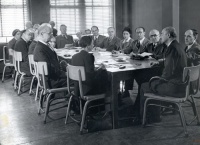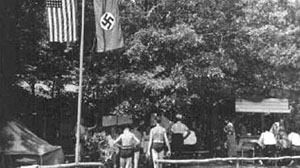From The Peopling of New York City
Contents |
Germans and the Irish
During the 1840s to the 1850s, Germans became active in the area of politics. In order to preserve their cultural background. As one of the more prominent groups in New York Germans began to gather power against those of the Irish in Tammy Hall. Other than political struggle Germans had economic clashes with the Irish.
In the 1890s, Germans sought out recognition within the churches of New York. Catholic churches were mostly occupied by the Irish. The failure of the Irish to allow Germans the ability to practice the religion in the manner they wanted sparked major conflict. In order to counteract the conflict the Germans joined the Cahenslyism movement sought approval for the concept that each nationality group should have its own parishes, priests, and schools as weel as a number of bishops proportionate to their percentage of Catholic population. Germans attempted to use this concept to preserve their culture in America and escape the domination of the Irish in the Churches. But, the Irish opposed this concept because they believed it would fragment American Catholicism, and they feared it would dilute their power within the Church. Because of the tension of the church conflict, the problems that were related to occupations and politics dissipated.[1]

Germans and the Jewish
Jews and Italians begin to move into Irish and German sections of New York during the 1890s. The action began to irritate the Irish which caused street fights between the Irish and the Jewish and the Irish and the Italian. Germans were mostly passive during this conflict.
The Germans and the Jewish were friendly with one another. They had common ideals and both were joined in the Socialist movement. The Antisemitism in Germany before World War I had little affect on German Jewish relations in New York. Many of the German newspapers offered opposition to the appearance of Antisemitism related material, but there were few anti-Semitism organizations within German-American communities which has little significant impact.[3]
During WWI
World War I was a horrid time period for the Germans. Many were accused of havign dual loyalties and being unpatriotic. They were despised as Huns in comparison to the Americans they thought they had become. All the torment and accusation caused Germans lose power in politics and soon they withdrew from politics all together.[4]

Nazism
Nazism was spread through German America. It emphasized antisemitism and exaggerated the decline of German American status in the United States. Nazism was prominent because of the reluctance of German Americans in criticizing anything from the motherland without all the details. Also there was the trauma experienced during WWI which German Americans feared would be revived if they were to criticize Nazism. In 1933 New York had the atmosphere where anti-German crusades seemed possible which also contributed to the lack of retaliation to Nazism by the Germans. Another reason for Nazism's spread in New York was because of Germany's new respect among the world which gave German Americans pride.
Many German Americans believed the news of Jewish oppression in Germany was exaggerated but they did admit that some anti-Jewish actions did occur. At the same time German Americans urged Jews not to overreact.
German Americans felt that the American government had no reason to see Germany as a threat but they should see it as any other country because of Jews attempt to keep the Olympics from being held in Berlin in 1936 and keeping Germany out of the World Fair in 1939.[6]
- Return to National and Global Events
- Return to Germans
References
- ↑ Bayor, Ronald H.. Neighbors in conflict: the Irish, Germans, Jews, and Italians of New York City. Baltimore: Johns Hopkins University Press, 1978. Print.
- ↑ http://library.albany.edu/speccoll/emigre.htm
- ↑ Bayor, Ronald H.. Neighbors in conflict: the Irish, Germans, Jews, and Italians of New York City. Baltimore: Johns Hopkins University Press, 1978. Print.
- ↑ Bayor, Ronald H.. Neighbors in conflict: the Irish, Germans, Jews, and Italians of New York City. Baltimore: Johns Hopkins University Press, 1978. Print.
- ↑ http://www.understandingrace.org/history/society/nazism.html
- ↑ Bayor, Ronald H.. Neighbors in conflict: the Irish, Germans, Jews, and Italians of New York City. Baltimore: Johns Hopkins University Press, 1978. Print.